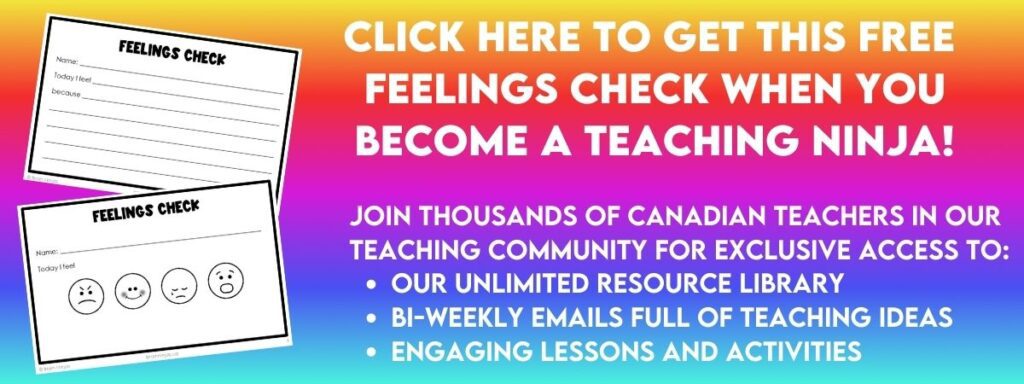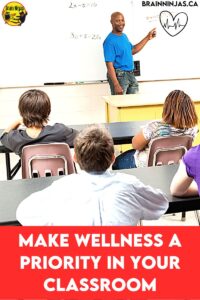
When the health and wellness curriculum just becomes a list of things to teach, it really misses the mark. If the goal of health and wellness lessons are to teach student life-long ways to take care of themselves, it should be woven throughout their days at school in addition to explicit teaching. We’ve evaluated some of the ways we put our wellness lessons front and centre in our classroom.
Use Wellness Lessons to Build Classroom Community
Building relationships is a health and wellness skill that doesn’t come naturally to all students. Students need to be explicitly taught how to be friends, how to work in groups and how to handle conflicts. Some students can’t make friends easily. Others are in constant conflict with their friends. Bullying is a problem in every school. We’ve created lessons specifically designed to help teach these skills.
Building Positive Relationships focuses on being a good friend and preventing bullying. Students learn how to identify bullying and then what to do about it when they are targeted or see it happening to someone else. It is available in our TpT Store and our Brain Ninjas Shop.
Group Roles and Processes is series of activities where students learn specifically about how to work in a group. Students are given specific tasks that focus on communication, compromise and working as a team. It is available in our TpT Store and our Brain Ninjas Shop.
Classroom Community are short activities that encourage students to work together through teamwork, collarboration and communication. It is available in our TpT Store and our Brain Ninjas Shop.
Expected and Unexpected Behaviours contains lessons to help teach students about social norms in your classroom, school and community. We typically use it at the beginning of the year to teach students what we expect, but also to teach other students how to respond when someone acts unexectedly. You can find it in our TpT Store and our Brain Ninjas Shop.
Use Wellness Lessons to Teach Students About Self-Regulation
When students don’t have language to describe their feelings, they can’t always express their emotions in healthy ways. Giving students vocabulary and examples of ways to self-regulate reduces the amount of time spent managing students because they can help themselves for most of the day to day strife.
Managing Feelings is a unit filled with activities to help student identify feelings and emotions. Students learn vocabulary as well as ways to use self-talk to help regulate emotions. It is available in our TpT Store and our Brain Ninjas Shop.
We have a set of free feelings check exit slips available in our Resource Library if you are a member of our email list. Otherwise, we can send a copy directly to your inbox when you sign up.
We teach students different ways to breathe using breathing exercises. This is a great way to calm the classroom back down after an exciting moment, gym class, or recess break and best of all, it’s really simple. Breathe in as if sucking on a straw for the count of four. Then slowly breathe out as if blowing out a candle for the count of four. This forces you to slow down your breathing.
Another activity that has worked well for students is drawing a shape in the air. Think of a square out in front of you. Slowly trace each side of the square with your finger in the air while breathing slowly. In fact, some students prefer to trace a shape on the wall. Encourage students to slow down and breathe until they can tell you how they are feeling or what is causing the feelings.
If you’re looking for more ideas to teach self-regulation, try reading our post How to Teach Students to Self-Regulate.
Use Wellness Practices for Food and Snacks
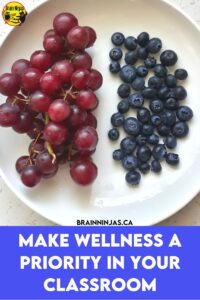
Don’t worry, this isn’t a post about healthy eating. But, allowing students to drink water throughout the day and use the washroom as needed promotes healthy living. We allow water bottles with secure lids in our room almost all the time. Students keep them on a shelf away from their desks when we are using laptops or Chromebooks. This prevents accidents. We don’t allow any other liquids in water bottles mainly because if they spill they create more of a mess.
We allow subtle snacking in our class. Students are taught that during independent work they can grab a quick and discreet snack if they are hungry. We joke with them about not serving a whole buffet. A snack is a few quick bites to get you through to the next recess or lunch break. Show students examples of good snack choices: a few carrot sticks, a couple crackers, a granola bar, or piece of cheese. They make good snacks because they are quick to eat and don’t require dishes or a big clean up. Examples of bad snacks are soup, anything that needs a fork or spoon, cooked fish or something that requires assembly like a charcuterie board.
We tend to let students eat their snacks after a recess break. This lets them play and move during recess and provides a calming effect when they return to class.
Wellness Choices contains lessons specifically about food choices through a series of lessons. There are also activities about water intake, sleep and exercise. It is available in our TpT Store and our Brain Ninjas Shop.
Use Wellness Lessons to Get Your Students Moving
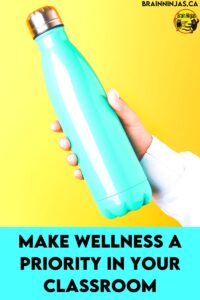
Studies have shown for years that movement helps increase brain activity and it’s good for your heart and lungs. We are fortunate in that our students get two fifteen minute recesses and another twenty minutes during lunch to play outside. They are pretty good at finding things to do outside, but if you’re looking for ideas, try our post Why You Should Revive Old Playground Games.
For brain breaks, we have used gonoodle.com in the past, but our students are looking for things that are a little older. We actually gathered up lots of ideas in our post Energize Your Gym Class With Very Little Equipment. One our favourite things to do is go for a quick walk around the neighbourhood. Just being outside and moving for 10-15 minutes can be enough to reinvigorate students. The next time to do this is before a test (or after) to help students spend a little time in nature.
Use Wellness Lessons to Keep Students Safe
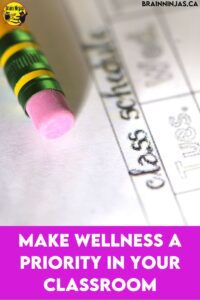
Build in safety rules by explaining why the rules are needed. Start by introducing basic safety rules in a health class setting and then practice them as you move through the school day.
For example, introduce a fire drill and all your expectations for it. Talk about why a fire drill is important and what needs to happen. Practice lining up and walking out to your muster point with your class before the schoolwide scheduled one. This works perfectly right up against a recess break so your students can stay outside and play. When they come back in, play a quick game to review all the steps. Repeat this process with lockdowns, tornado drills or any other emergency drills your students do.
Turn the safety rules out to the world with recreational activities (like swimming or biking), online activities (cyberbullying and protecting your identity online) or injury prevention (like falls or sharps objects).
There is an entire lesson on personal boundaries and consent. It is age-appropriate and uses examples from the classroom to explain how consent works and why it is important.
We’ve already written all these lessons for you in our Safety and Responsibility unit available in our TpT Store and our Brain Ninjas Shop.
Use Wellness to Help Student Become Life-Long Learners
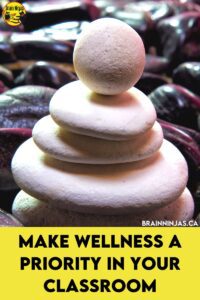
Organization
Some students love to be organized and for others, it’s just not a priority. Some students need to be taught basic organization and others don’t see the point. Start by showing students how being organized can help be more efficient and reduce anxiety because you’re not always looking for things. Help students organize their personal areas like desks, lockers or backpacks without being in their space or making them organize in your way.
For example, if a student struggles with finding their pencil every single class, sit down and devise a plan for where the best place to store a pencil would be. One of our students decided that taping his pencil to the side of this desk was the best place to store it. Before leaving his desk, he taped it back. We went a whole week not looking for a pencil and it was amazing. Then he changed the pencil to taping inside his desk until he built in the habit of putting it away before leaving his desk, so it never rolled away again.
Time Management
Time management is another area where many students need help. When working on big projects, help your students manage their time by breaking big tasks down into smaller steps. Our post How to Keep Students Accountable During Project Based Learning has ideas about how to help students with their time management.
Perseverance
Teaching students to work through difficulties takes time. We have a blog post to help teach students about how to develop a growth mindset. Read Use the Learning Pit to Teach Growth Mindset for more information. We also have a lesson in our Life-Long Learning Unit available in our TpT Store and our Brain Ninjas Shop.
Goal Setting
Goal setting is always a big focus in schools, but most of the time students struggle with choosing appropriate goals and then managing them. Instead, try to helping students set smaller goals that are realistic and can be the building blocks to bigger goals.
Decision Making
Decision making is a skill that some students need to learn explicitly. We made a simple lesson that is available for free in our TpT Store and our Brain Ninjas Shop.
All of these lessons and more are included in our Life-Long Learning unit. It is available in our TpT Store and our Brain Ninjas Shop.
Get All Your Health and Wellness Lessons at Once
We have all of our wellness lessons in one big bundle for grades four through six. The bundle also includes supplemental materials and comes at a discount. In addition to all the units mentioned in this post, it comes with a unit for Financial Literacy (in our TpT Store and Brain Ninjas Shop) and Online Safety and Digital Citizenship (in our TpT Store and Brain Ninjas Shop).
Find the Whole Year Bundle in our Teachers Pay Teachers Store or Brain Ninjas Shop. It even comes with a digital version!
Wellness Lessons are Life Lessons
Wellness skills are life-long skills that benefit everyone. It’s important for students to see these skills in action throughout their days if they are going to build them into their entire lives. How do you bring wellness lessons into your classroom every day? Tell us about it in the comments below.
Looking for More Wellness Ideas?
These posts might be helpful to you.
Use the Learning Pit to Teach Growth Mindset
Use Pink Shirt Day to Make a Difference in the World
You Need to Stop Overlooking Health Class!
How to Weave Kindness into the Classroom Every Day
The Secrets of Social Emotional Learning for Kids

